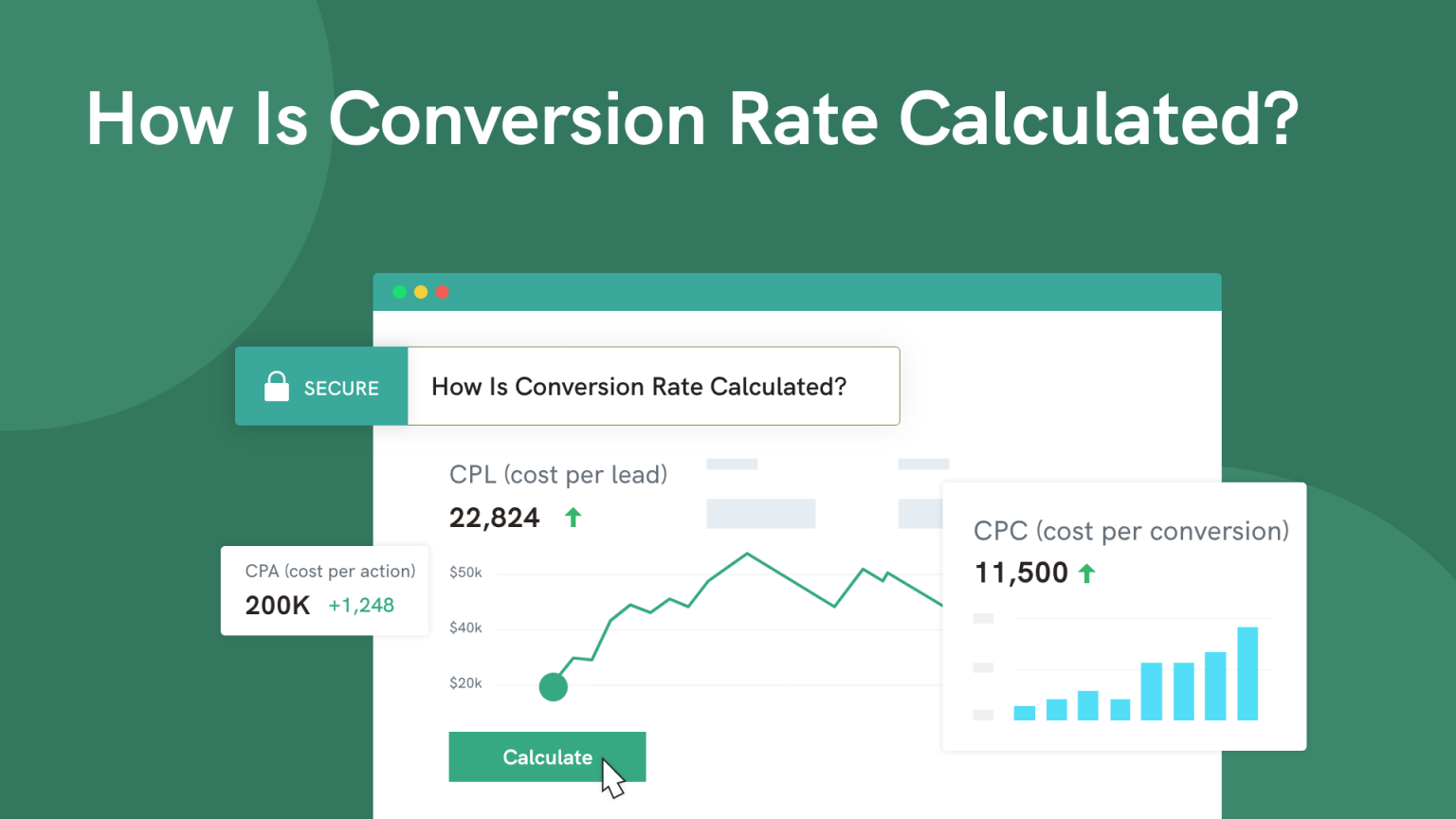As a marketer, you’re likely familiar with the question, “What is your conversion rate?” during online advertising campaigns.
While some perceive conversion rate calculation as complex, it’s a straightforward formula essential for measuring the performance of your advertising efforts.
In the dynamic sales world, understanding and accurately calculating your conversion rate is crucial—it’s the key to unlocking your business’s potential and driving growth.
In this article, we’ll explore everything you need to know about conversion rates: how to calculate them accurately, what they are, and the different optimization strategies.
Understanding and Calculating Conversion Rates
What is a Conversion Rate?
A conversion rate is a metric that helps businesses measure the effectiveness of their advertising campaigns.
It’s a simple formula used to calculate the percentage of visitors who complete a desired action (like making a purchase or signing up for a newsletter) on your website or landing page.
This metric is vital for assessing the performance of your marketing campaigns and optimizing them for better results.
Conversion Rates Formula:
The number of conversions is divided by the total number of visitors, a simple conversion rate calculating formula used to identify the conversion rate for any advertising campaign.
or
Conversion rate = (Total no. of Conversions / Total no. of visitors)*100
With this formula, you can find your business’s conversion rate.
For example: If your e-commerce store gets 200 visitors and converts into 50 sales, its e-commerce conversion rate formula is 50 divided by 200 and multiplied by 100, i.e., 25%.
If you’re running an e-commerce store and want to analyze your store’s conversion rate performance, you can use this e-commerce conversion rate formula.
Similarly, companies use other conversion rates to track their marketing campaigns as per results.
CPL, CPC, CCR, and CPA are the most common terms used by advertising campaigns to track performance.
Let’s discuss this in detail!
CPL (Cost Per Lead)
CPL (Cost Per Lead) is a conversion metric used to determine the cost for each lead generation through advertising campaigns.
Many businesses use the Cost-per-Lead (CPL) metric to determine their cost per lead and optimize their campaigns to generate more leads at lower costs.
The Cost Per Lead formula is:
Cost Per Lead (CPL) = Total campaign cost / Total amount of leads
CPA (Cost Per Action)
CPA (Cost Per Action) is used by businesses to identify the cost for each result.
With this metric, we can find the cost for each result like sign-up, sales, form etc.
Cost Per Action formula is:
CPA = Total campaign cost / Total amount of conversions
CCR (Click Conversion Rate)
Businesses use CCR (Click Conversion Rate) to determine the conversion percentage based on the total number of clicks.
Click Conversion Rate formula is:
Click Conversion Rate (CPC) = Total number of conversions / Total number of clicks
CPC (Cost Per Conversion)
CPC (Cost Per Conversion) is used to identify the cost for each conversion.
Businesses are using this metric to know the cost for each result. The cost Per Conversion formula is:
CPC = Total campaign cost / Total amount of conversion
These are some important metrics used to calculate the conversion rate.
You can also use a conversion rate calculator to determine the conversion rate.
Also, you need to measure the keyword conversion rate if you’re running a PPC campaign.
Types of Conversions in Marketing and Analytics
Conversions are a fundamental concept in marketing and analytics, referring to the process where an individual takes a specific desired action.
These actions can vary widely depending on the context, such as a website visit, a purchase, or a sign-up.
Understanding different types of conversions is crucial for businesses to effectively measure and optimize their marketing strategies, website design, and overall user experience.
Below are several key types of conversions:
1. Macro Conversions
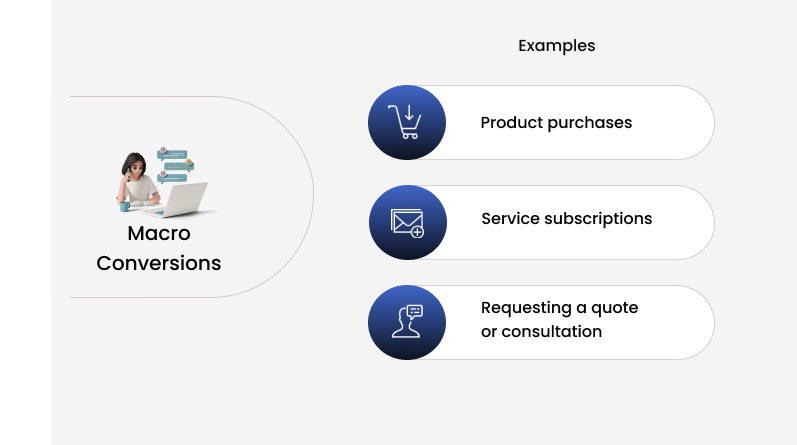
These are the primary objectives of a website or campaign, often directly related to revenue.
Examples include:
- Product purchases
- Service subscriptions
- Requesting a quote or consultation
2. Micro Conversions
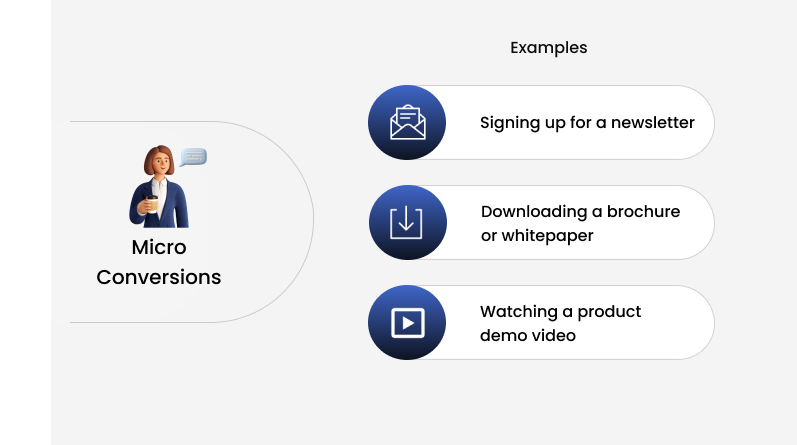
These are smaller actions that lead toward a macro conversion, indicating user engagement and interest.
Examples include:
- Signing up for a newsletter
- Downloading a brochure or whitepaper
- Watching a product demo video
3. Lead Generation Conversions
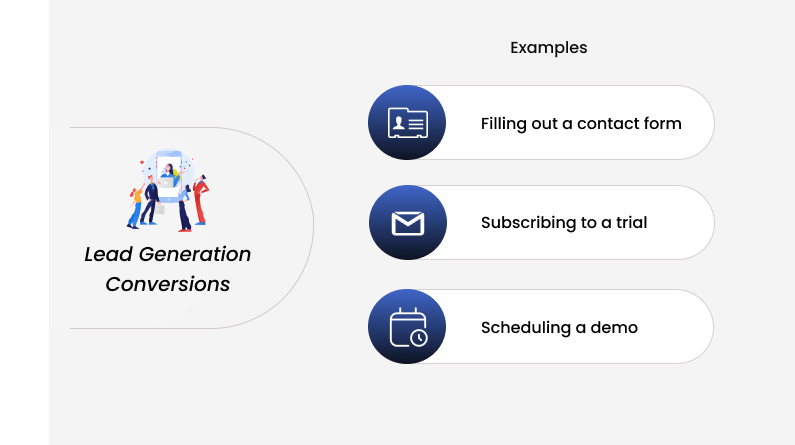
Specifically for businesses that rely on generating leads to eventually close sales.
This includes actions such as:
- Filling out a contact form
- Subscribing to a trial
- Scheduling a demo
4. E-commerce Conversions
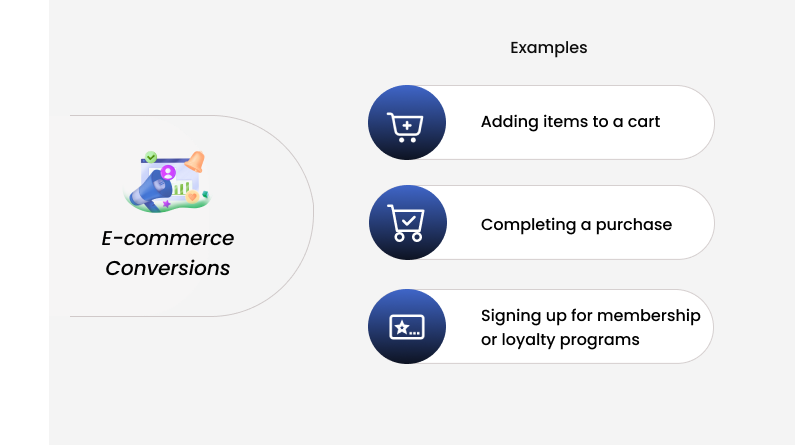
Relevant for online retail and e-commerce sites, focusing on:
- Adding items to a cart
- Completing a purchase
- Signing up for membership or loyalty programs
5. Content Conversions
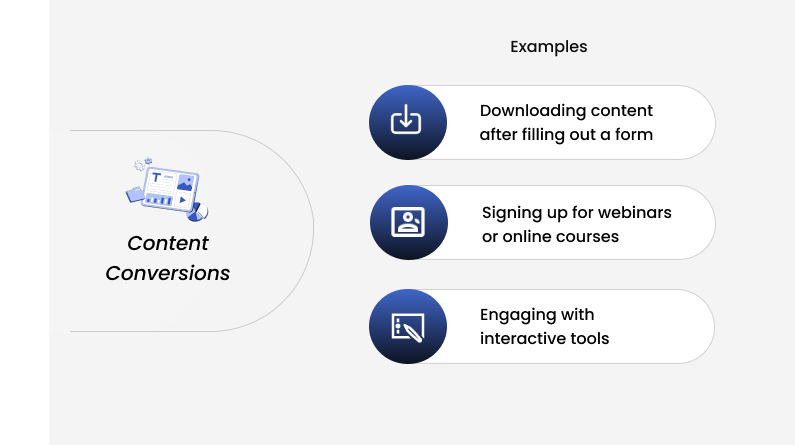
These conversions are focused on engaging users with content, suitable for content-driven sites like blogs or educational platforms.
Examples include:
- Downloading content after filling out a form
- Signing up for webinars or online courses
- Engaging with interactive tools
6. Social Media Conversions
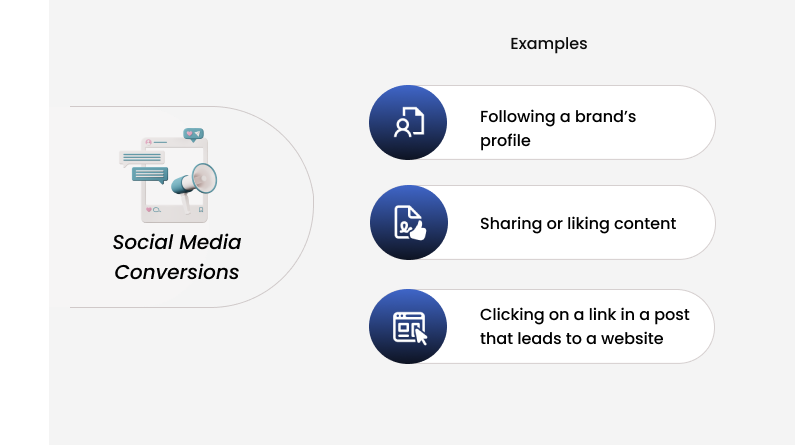
Conversions that happen on social media platforms, including:
- Following a brand’s profile
- Sharing or liking content
- Clicking on a link in a post that leads to a website
7. Event Conversions
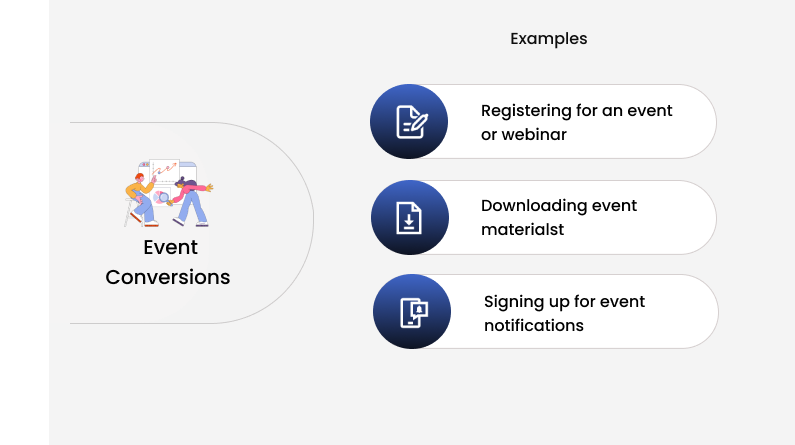
For businesses that host or participate in events, conversions might include:
- Registering for an event or webinar
- Downloading event materials
- Signing up for event notifications
8. Subscription Conversions
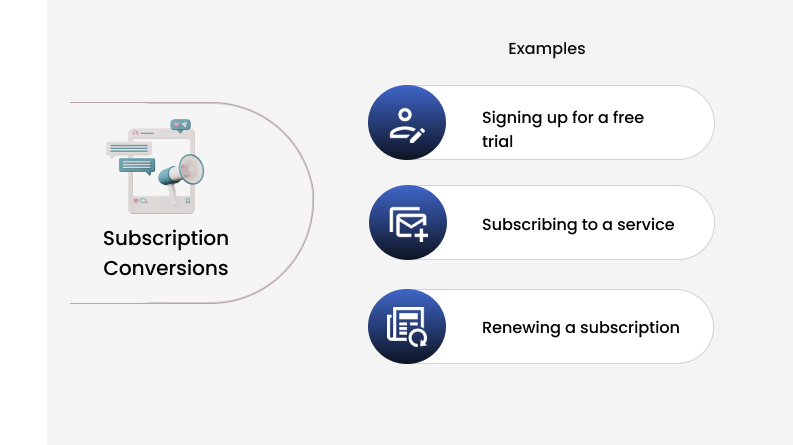
Relevant for businesses that offer digital subscriptions or services.
Actions include:
- Signing up for a free trial
- Subscribing to a service (monthly, yearly)
- Renewing a subscription
Why is Conversion Rate Important?
The conversion rate is an important factor for their business growth.
With conversion rate, it’s easy to identify the performance of advertising campaigns on different platforms, which works best for their business, and what actions must be taken after reviewing the performance of advertising campaigns.
Knowing how many people are interested in and buying the product is important.
Later, you can change your campaign to target only potential customers to increase sales and business.
In simple words, conversion rate helps you know whether your efforts are put in the right place or if you need to make some changes to get the desired results.
Companies need to keep analyzing their conversion rate to direct their efforts in the right direction and eliminate obstacles to their business.
Best Tools for Tracking Conversion Rate
To enhance your marketing campaign’s conversion rate, it’s vital to rely on precise data from past initiatives.
Specialized tracking tools can offer these exact metrics, enabling you to make data-driven decisions for campaign optimization.
Here are some leading tools to consider:
- Google Analytics: An all-encompassing solution for tracking visitor behavior and conversion metrics on your website.
- Hotjar: Provides heatmaps and user activity recordings, shedding light on user interactions on your site.
- Crazy Egg: Delivers insights using heatmaps, scrollmaps, and A/B tests to fine-tune conversions.
- Mixpanel: Offers detailed analytics to assess and elevate your conversion rates.
Dive into these tools to gather critical insights, tweak your strategies, and elevate your conversion outcomes.
Additionally, for e-commerce businesses looking to analyze their return on investment further, the WiserNotify E-commerce ROI Calculator can be an invaluable tool.
It helps in understanding how conversion rates impact your overall business profitability, allowing you to make more informed decisions about your marketing strategies.
Also See: 20 Free and Paid Conversion Rate Optimization Tools
How to Improve Your Conversion Rate?
Conversion Rate is mainly used to analyze the performance of advertising campaigns and later make changes in campaigns to get better results.
It’s also known as conversion rate optimization (CRO) to find out why you’re not getting campaign results and the best way to resolve the problem.
A/B Testing
A/B testing is the most preferred way to analyze the performance of your marketing campaigns and find real insights. With A/B Testing, you can compare two advertising campaigns and find which one works better.
Once you’ve set up two marketing campaigns and run ads for the same results but the different audiences, websites, and elements, then you need to consider these elements in A/B Testing:
1. Define your conversion goal (e.g., sales, sign-ups).
2. Identify where and why potential customers are leaving.
3. List required changes to improve campaign performance.
4. Implement A/B testing with the proposed changes.
5. Set a duration for the A/B test to achieve desired results.
6. Analyze the results and adjust strategies accordingly.
Social Proof Notifications
Social proof notifications are one of the most powerful and in-demand marketing strategies many businesses use to increase their sales and conversion rates.
You can add social pop-up notifications to your website to attract potential customers, generate quality leads, and increase your sales.
Social proof notifications are useful for e-commerce stores, websites, and landing pages to display pop-up notifications and encourage visitors to take similar actions.
To increase your conversion rate and grow your business, you need to add social proof notifications.
WiserNotify is the #1 best social proof notifications platform. It supports 250+ platforms, including CRM, Landing Page builder, email marketing tools, etc.
With WiserNotify, you can display different notifications on your website and increase your conversion rate.
You can create a free account on WiserNotify and connect with 200+ platforms to display social proof notifications and increase your conversion rate.
Optimize Website/Landing Page
An attractive website or landing page is essential for any business to generate qualified leads and convert them into customers.
With a landing page, promoting products or services is easy and encourages visitors to make buying decisions.
You need to convert your simple website into a powerful, appealing, attractive one with call-to-actions, newsletter subscription, chatbot, etc., and increase the conversion rate.
Create Useful Blogs
You can also start writing useful and valuable blogs to provide valuable information to your potential customers and build trust for your brand.
With blogging, you can generate potential customer traffic on your website that can convert into sales.
It’s the most effective and organic way to target potential customers and encourage them to make buying decisions faster.
Leverage Social media Marketing
Billions of people are actively using social media platforms, and surely your potential customers.
So, if your potential customers are on social media, why are you not taking action to get in front of them and promote your products/services?
You need to build a strong presence on Facebook, Instagram, Twitter, and YouTube to catch your customers’ attention and encourage them to make faster buying decisions.
Email Marketing
Email marketing is the most preferred marketing strategy to attract potential customers to your site and increase sales.
Almost every business uses email marketing to attract customers, generate qualified leads, nurture leads, and increase sales and conversions.
Email marketing is a platform where he can consistently promote your products/services to potential customers and build trust towards your brand.
Email marketing is not a one-shot game; it’s catching customers’ attention, generating qualified leads, nurturing leads, and increasing sales.
Factors that affect the Conversion Rate
By analyzing the performance of advertising campaigns, businesses can improve the conversion rate, but other factors can also affect the conversion rate.
We’ve handpicked some major factors that you should consider to increase your conversion rate:
- Fewer Payment options
- Poor landing page
- Slow loading speed
- Captcha requests to access the website
- High-quality photos
- Wrong colors selection
- Unsafe payment process
- The complex process of finding out something
- Unreadable fonts
- Wrong link added in buttons
There are many more factors that can affect the conversion rate for any business.
So, it’s essential to consider these factors and improve the marketing campaigns accordingly to improve the conversion rate and get better results.
Conclusion
Conversion rate is one of the essential metrics that many businesses use to analyze the performance of advertising campaigns and take action accordingly to increase results.
We hope this article helps you understand conversion rate and its types so that when someone asks about it, you can confidently answer.
If you want to increase your business’s conversion rate, follow the tips and create a free account in WiserNotify to display amazing social proof notifications and grow your business.
